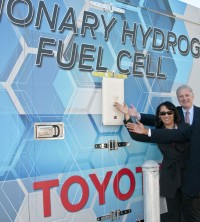Toyota Powers-Up First Of Its Kind Stationary Fuel Cell
 Toyota Motor Sales, USA, Inc. activated a new 1.1-megawatt hydrogen fuel cell generator on the Torrance headquarters campus on October 17. The fuel cell will supply approximately half of the electricity for six headquarters buildings during peak demand, while producing zero emissions.
Toyota Motor Sales, USA, Inc. activated a new 1.1-megawatt hydrogen fuel cell generator on the Torrance headquarters campus on October 17. The fuel cell will supply approximately half of the electricity for six headquarters buildings during peak demand, while producing zero emissions.
Designed and built by Ballard Power Systems, the proprietary Proton Exchange Membrane (PEM) stationary fuel cell is the largest PEM fuel cell of its kind. The fuel cell is powered by hydrogen gas fed directly from a pre-existing industrial hydrogen pipeline, also a first for this technology. This direct power source allows Toyota to reduce utility grid electricity usage during peak power demand. The same hydrogen pipeline also supplies a hydrogen filling station adjacent to the TMS campus used to fuel Toyota's and other manufacturers fuel cell hybrid vehicle fleets.
At 1.1 MW, the clean energy fuel cell system on average provides enough power for about 765 homes, twice the capacity of Toyota's existing solar panel system on campus. It is expected to reduce CO2 emissions by 3.3 million pounds during summer peak period operating hours, the equivalent to taking 294 cars off the road a year.
The Toyota Fuel Cell Hybrid Vehicle – Advanced (FCHV-adv) is also powered by PEM fuel cell technology. PEM technology is uniquely suited for stationary applications as it provides quick power availability vs. a long "warm up" period prior to power generation.
Hydrogen within the dedicated pipeline is provided by Air Products and created from natural gas reformation. To mitigate emissions from the reformation process, hydrogen used on Toyota's campus will be offset with the purchase of landfill generated renewable bio-gas. Operation of the stationary fuel cell creates zero air emissions.
Electricity generated by the fuel cell fuel is expected to save Toyota approximately $130,000 a year in reduced energy purchased from Southern California Edison.
Additional project funding was provided by Sustainable Development Technology Canada and California's Self-Generation Incentive Program.
 Toyota Motor Sales, USA, Inc. activated a new 1.1-megawatt hydrogen fuel cell generator on the Torrance headquarters campus on October 17. The fuel cell will supply approximately half of the electricity for six headquarters buildings during peak demand, while producing zero emissions.
Toyota Motor Sales, USA, Inc. activated a new 1.1-megawatt hydrogen fuel cell generator on the Torrance headquarters campus on October 17. The fuel cell will supply approximately half of the electricity for six headquarters buildings during peak demand, while producing zero emissions.